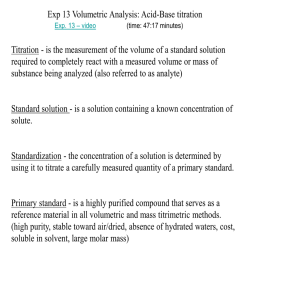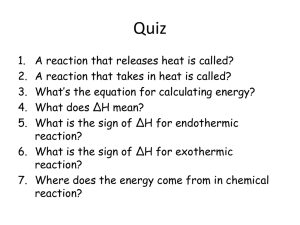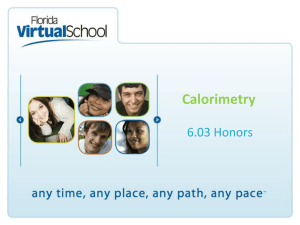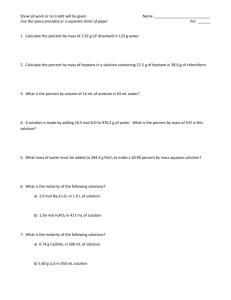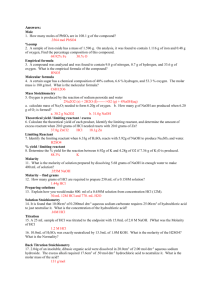Reaction 1. The enthalpy of neutralization of HCl(aq) and NaOH(aq)
advertisement
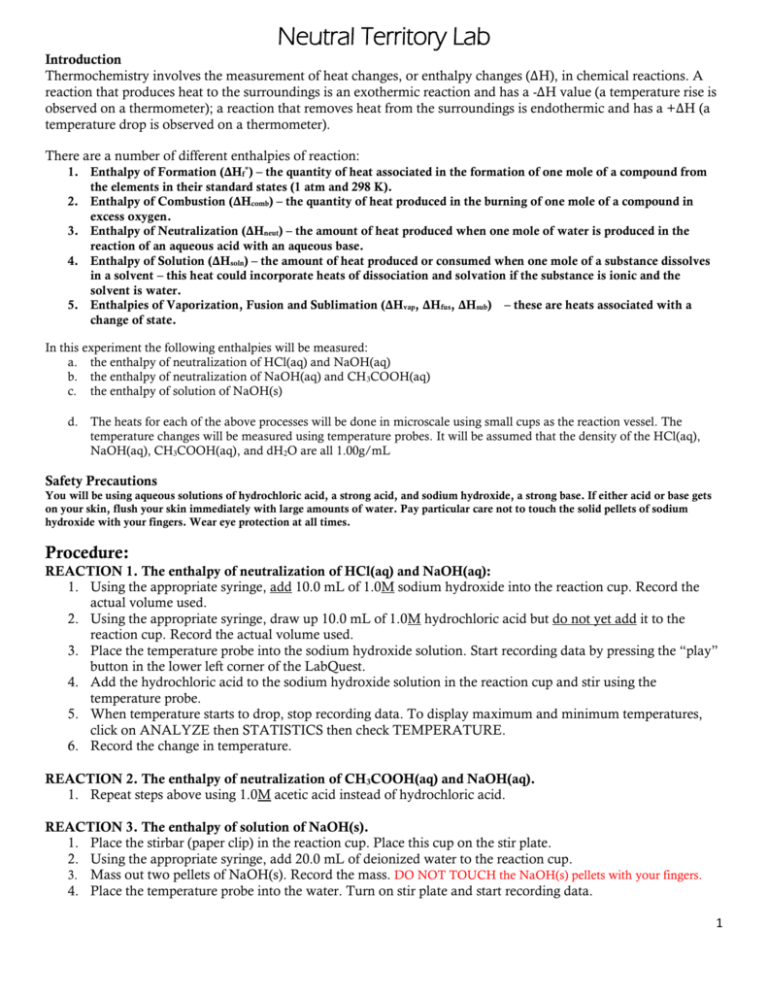
Neutral Territory Lab Introduction Thermochemistry involves the measurement of heat changes, or enthalpy changes (ΔH), in chemical reactions. A reaction that produces heat to the surroundings is an exothermic reaction and has a -ΔH value (a temperature rise is observed on a thermometer); a reaction that removes heat from the surroundings is endothermic and has a +ΔH (a temperature drop is observed on a thermometer). There are a number of different enthalpies of reaction: 1. Enthalpy of Formation (ΔHf˚) – the quantity of heat associated in the formation of one mole of a compound from the elements in their standard states (1 atm and 298 K). 2. Enthalpy of Combustion (ΔHcomb) – the quantity of heat produced in the burning of one mole of a compound in excess oxygen. 3. Enthalpy of Neutralization (ΔHneut) – the amount of heat produced when one mole of water is produced in the reaction of an aqueous acid with an aqueous base. 4. Enthalpy of Solution (ΔHsoln) – the amount of heat produced or consumed when one mole of a substance dissolves in a solvent – this heat could incorporate heats of dissociation and solvation if the substance is ionic and the solvent is water. 5. Enthalpies of Vaporization, Fusion and Sublimation (ΔHvap, ΔHfus, ΔHsub) – these are heats associated with a change of state. In this experiment the following enthalpies will be measured: a. the enthalpy of neutralization of HCl(aq) and NaOH(aq) b. the enthalpy of neutralization of NaOH(aq) and CH3COOH(aq) c. the enthalpy of solution of NaOH(s) d. The heats for each of the above processes will be done in microscale using small cups as the reaction vessel. The temperature changes will be measured using temperature probes. It will be assumed that the density of the HCl(aq), NaOH(aq), CH3COOH(aq), and dH2O are all 1.00g/mL Safety Precautions You will be using aqueous solutions of hydrochloric acid, a strong acid, and sodium hydroxide, a strong base. If either acid or base gets on your skin, flush your skin immediately with large amounts of water. Pay particular care not to touch the solid pellets of sodium hydroxide with your fingers. Wear eye protection at all times. Procedure: REACTION 1. The enthalpy of neutralization of HCl(aq) and NaOH(aq): 1. Using the appropriate syringe, add 10.0 mL of 1.0M sodium hydroxide into the reaction cup. Record the actual volume used. 2. Using the appropriate syringe, draw up 10.0 mL of 1.0M hydrochloric acid but do not yet add it to the reaction cup. Record the actual volume used. 3. Place the temperature probe into the sodium hydroxide solution. Start recording data by pressing the “play” button in the lower left corner of the LabQuest. 4. Add the hydrochloric acid to the sodium hydroxide solution in the reaction cup and stir using the temperature probe. 5. When temperature starts to drop, stop recording data. To display maximum and minimum temperatures, click on ANALYZE then STATISTICS then check TEMPERATURE. 6. Record the change in temperature. REACTION 2. The enthalpy of neutralization of CH 3COOH(aq) and NaOH(aq). 1. Repeat steps above using 1.0M acetic acid instead of hydrochloric acid. REACTION 3. The enthalpy of solution of NaOH(s). 1. Place the stirbar (paper clip) in the reaction cup. Place this cup on the stir plate. 2. Using the appropriate syringe, add 20.0 mL of deionized water to the reaction cup. 3. Mass out two pellets of NaOH(s). Record the mass. DO NOT TOUCH the NaOH(s) pellets with your fingers. 4. Place the temperature probe into the water. Turn on stir plate and start recording data. 1 5. Using the forceps, add the NaOH(s) pellets. Make sure the temperature probe stays submerged while recording. 6. When temperature starts to drop, stop recording data. To display maximum and minimum temperatures, click on ANALYZE then STATISTICS then check TEMPERATURE. Write the net ionic equation RXN 1: Fill in the table below. Show all calculations in the area below. Reaction 1. The enthalpy of neutralization of HCl(aq) and NaOH(aq) Molarity of HCl (mol/L) Molarity of NaOH (mol/L) Volume of HCl (mL) Volume of NaOH (mL) Moles of HCl (mol) Moles of NaOH (mol) Total mass of solution (g) Specific heat capacity ΔT from graph (˚C) q (J or cal) ΔH/mol limiting reactant from graph (kJ/mol) Limiting Reactant Write the net ionic equation RXN 2: Fill in the table below. Show all calculations in the area below. Reaction 2. The enthalpy of neutralization of CH3COOH(aq) and NaOH(aq) Molarity of CH3COOH (mol/L) Volume of CH3COOH (mL) Moles of CH3COOH (mol) Molarity of NaOH (mol/L) Volume of NaOH (mL) Moles of NaOH (mol) 2 Total mass of solution (g) Specific heat capacity ΔT from graph (˚C) q (J or cal) ΔH/mol limiting reactant from graph (kJ/mol) Limiting Reactant Write the net ionic equation RXN 3: Fill in the table below. Show all calculations in the area below. Reaction 3. The enthalpy of solution of NaOH(s) Volume of H2O (mL) Mass of NaOH(s) (g) Total mass of solution (g) Moles of NaOH(s) (mol) ΔT from graph (˚C) q (J or cal) ΔH/mol limiting reactant from graph (kJ/mol) Limiting Reactant Conclusion: 1) Use the accepted values in the table to determine the percent error for each reaction. Accepted Enthalpy Values ΔHneut HCl(aq) and NaOH(aq) -57.1 kJ/mol ΔHneut NaOH(aq) and CH3COOH(aq) -55.9 kJ/mol ΔHsoln NaOH(s) -44.5 kJ/mol 2) Explain errors involved. Error involved in reactions 1 and 2 Effect on result 3 Error involved in reaction 3 Effect on result 4

